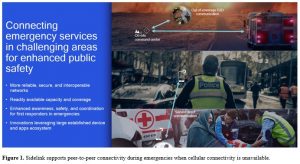Updated: How ‘sidelink’ peer-to-peer communications can enhance public-safety operations
Editor’s note: A previous version of this column was posted that included only the first portion of the article—a mistake by the editor. IWCE’s Urgent Communications regrets the error and apologizes for any inconvenience.
When first responders are called to action, they need reliable communications to coordinate an effective public-safety response. Public-safety personnel understand this crucial correlation and have long sought an enhanced peer-to-peer communications capability within the cellular arena served by the 3GPP standards body. This capability is one of the primary requirements for migrating to broadband communications. 5G sidelink is designed to serve this need.
Sidelink is direct, user-to-user communications without the need for network infrastructure, supporting communications between first responders at the scene of an emergency where cellular connectivity may be unavailable.
Additionally, sidelink is part of the latest generation of cellular technology called 5G, enabling it to operate seamlessly with the nationwide 5G operational ecosystem. This ecosystem consists of wireless networks, connected user devices, and cloud computing to provide seamless end-to-end connectivity and services for users.
Sidelink enables direct communications among first responders
Sidelink provides reliable, low-latency communications directly between first responders in all locations, including places where cellular connectivity may not reach, like multi-level basements, within concrete-reinforced walls, building stairwells, and places where wildfires often rage. Because sidelink does not need a centralized controller like traditional network-based communications, first responders can use sidelink where cellular connectivity is unavailable or overloaded as a result of heightened traffic in the aftermath of a natural disaster or other public emergency.
Interoperability is a core feature of sidelink: its device-to-device communications capability enables multiple public-safety agencies—such as police and fire personnel from the same or different jurisdictions—to talk directly with one another during a crisis.
Sidelink operates in multiple configurations. First responders can leverage sidelink’s device-to-device capability on their radios autonomously using spectrum sensing. This capability becomes even more impactful by adding a local, nomadic, private network, such as by using first-responder vehicles—for example, fire trucks and police vans—as on-site command centers and mobile base stations.
These command centers enable monitoring of the emergency situation, while supporting coordinated operations for first responders on site, like the identification and rescue of personnel in distress.
Additionally, command centers with mobile base stations can deliver backhaul network connectivity using existing cellular infrastructure.
These features make sidelink a crucial communications capability when first responders need it the most, whether that is fighting a fire in a remote parkland or in an office building, responding to hostage rescue situations in building basements traditional land-mobile-radio (LMR) and cellular signals are unavailable. (article continues below graphic)

Sidelink builds upon previous peer-to-peer capabilities, also known as Proximity Services (ProSe), providing direct communications with enhanced reliability and much higher data rates, and millisecond latency. A key improvement from ProSe is sidelink’s improved range: it can extend its roughly one-kilometer communications range via multi-hop or mesh-network relay connections.
For instance, a first responder with a sidelink-enabled device located in a multi-level basement in a building can still communicate to the on-site command center through multi-hop connections using other sidelink-enabled devices within sufficient proximity of one another and the command center. It does this without materially degrading the intervening devices’ precious battery resources. This sidelink-enabled device could vary from a handheld radio to a wearable device capable of monitoring and sharing a first responder’s vital-sign data and environmental data (e.g., temperature and air quality) with other first responders nearby and the command center.
Sidelink can support hundreds of devices at the scene of an emergency. It can support communications between multiple floors in a building and has a range of a few kilometers outdoors when operating in spectrum below 6 GHz. Taken together, sidelink can provide first responders with readily available capacity and coverage in dynamic environments to meet their critical communication needs.
Sidelink is 3GPP standardized
Sidelink communications has been standardized in the Third Generation Partnership Project (“3GPP”). The sidelink standard defines mission-critical services such as push-to-talk voice and video and prioritized access of different services over the same communications channel. This capability enables coordination of primary public-safety and secondary non-public-safety operations on the same channel, maintaining a high quality of service for public-safety communications without being impacted by secondary operations.
Sidelink has been designed to meet diverse 5G requirements, supporting a range of commercial applications like extended reality, IoT needs, data offload, and improved positioning accuracy. Further enhancements to sidelink via upcoming standards improvements can allow operations in different spectrum bands and under different licensing regimes, e.g., licensed, unlicensed, and shared spectrum.
The standardization of sidelink technology through 3GPP facilitates the adoption of the technology. This enables inter-vendor system interoperability, as well regulatory adoption and compliance, that allows sidelink-enabled equipment manufacturers to reach economies of scale, thereby lowering costs of deployment.
Achieving this goal is feasible given that sidelink has many commercial applications, in addition to the more critically important public safety applications. Additionally, permitting commercial applications on a secondary basis to primary public safety communications will further drive down device costs for all users and enable useful low-power device-to-device links for local sharing of media and messaging.
Sidelink can operate in the 4.9 GHz public-safety band
Recently, the Federal Communications Commission (“FCC”) released a Report and Order and Further Notice of Proposed Rulemaking for the 4.9 GHz (4940-4990 MHz) public-safety band. This band, which presently supports fixed public safety communication links, can be a home for sidelink communications applications.
In order to support sidelink and associated interoperability among a diverse set of public-safety, non-public-safety, and commercial users and applications, the FCC can adopt the 3GPP standard for sidelink or provide authority to the proposed Nationwide Band Manager to do so. If adopted, first responders would have priority access to the 4.9 GHz band during emergencies, as well as access to sidelink on a priority basis.
Summary
Sidelink is a critical public safety communications tool. The public-safety community can enable use of the technology in the 4.9 GHz band, where the FCC is aiming to promote more intensive and enhanced public-safety communications.
Leslie Barnes is with Qualcomm Incorporated and represents the company before the FCC and other federal agencies. She can be reached at [email protected]. Bill Maheu is with Qualcomm Government Technologies and is responsible for working with government partners in bridging the gaps between commercial wireless capabilities and government missions. He is based in San Diego and can be reached at [email protected].



















Please correct the typo in the third instance where 4.9 is mentioned. 4.9 MHz –> 4.9 GHz
It is worth noting that multihop is not currently 3GPP standardised. It is an important candidate for 3GPP Release 19. Everyone should encourage all 3GPP members to consider this favourably during the 3GPP Release 19 prioritisation discussions over the coming months before the final decision in December 2023.